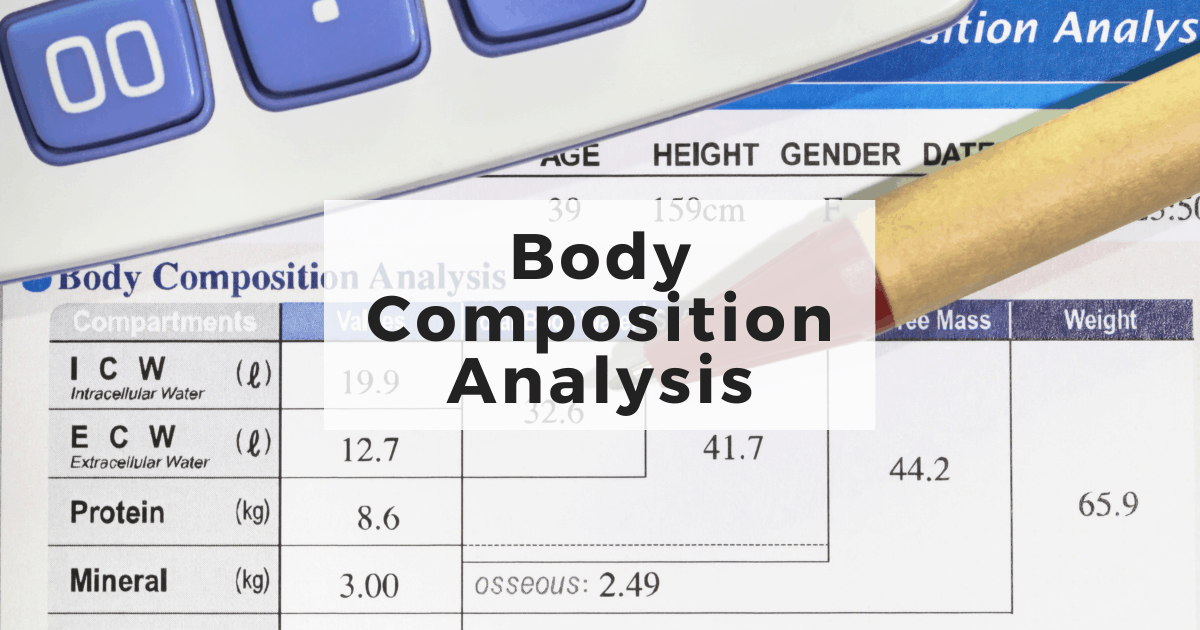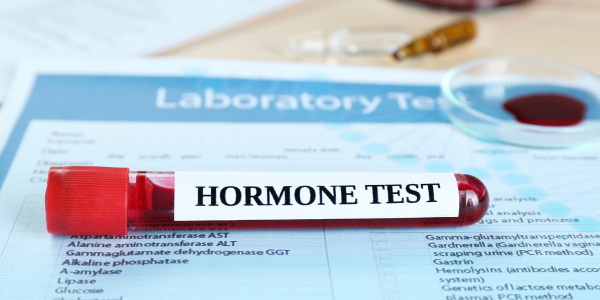

Hi, this is Dr. Emily Parke with your Next Functional Health Minute. Today I’d like to explore looking at body composition. So the scale gives you a weight and so that’s obviously just how much you overall weigh but it doesn’t tell you at all what you’re made up of. Doing an advanced body composition analysis can really let you know what’s going on with your body fat, with your lean muscle mass and your water. So that’s one of the reasons why I have what’s called an InBody 570 advanced body composition analysis analyzer at the office. So obviously it gives you your weight but it gives you all the other things I just mentioned. I’m going to show you a report and walk you through it and then I’m also going to talk about why you might want to really use the testing tool to figure out what your specific body composition is and how you can work on it.
So this is an example of a report and I’m going to go over all of the different items on this report. And by the way, if you come and get one done you get a printout every single time. And then I don’t know if you can see at the bottom there’s also, I know it’s backwards but there’s also a trend of what the important points are like the weight, the skeletal muscle mass, the percent body fat and the water weight of every single time that you’ve ever done the test, which you’ll get a new printout every time that you do it.
So obviously the top gives you a summary so it’ll tell you how much do you weigh, that’s your total weight, and then it’ll give you how much of your weight is considered lean body mass and then how much is considered dry lean mass so how much is extracellular water and intracellular water. So obviously you know our bodies are made up of mostly water so it’ll tell you how much is located inside the cells, that’s intracellular water, and extracellular water how much is outside the cells. Now that one can be really important. That can give us clues as to really your hydration status and inflammatory status too. So let’s say you’re inflamed, you completely went off your diet plan for example, you might actually be holding onto some extra water weight from that inflammation. And then of course, more serious conditions like if someone has a cardiac condition and they may be retaining fluid because their heart function might not be that good you can also determine these on this test as well.
So the next category is looking at the muscle fat analysis and that I like. This portion is really very telling so it’s your body weight and it’s your skeletal muscle mass and your body fat mass. So this middle section, hold it up here. You can see this person has almost like a C curve to this so what that means right away without even looking at the numbers is that this person has more body fat than they should and relative to the amount of lean muscle mass and their weight. So if their weight is high, their muscle mass is lower relative to their weight and their percent body fat is high. So it’s almost like a C.
If you have I like pattern that means everything is on the same line. So it means your weight, your skeletal muscle mass, and your percent body fat are all in line. Now, that may be ideal. If you’re in, I don’t know if you can see these little gray dashes there, that is an ideal range for you specifically. So if you’re female, age 44, you’re 5’1″ that puts it into where are the ideal range for you. So you could still have an I meaning you can still have your weight, your muscle mass and your body fat all be in line but they could all be way over here which would indicate that you would probably want to lose some body fat still but your muscle mass maybe good or over.
Then there’s the D pattern so that would be the opposite of this. Instead of looking this way it would look like this. So that is someone who has a lot of skeletal muscle mass and a lot of lean body mass. So that may be someone like a weightlifter for example, someone who does athletics for a living and carries more lean muscle mass than the average person. So ideally you want your little pattern there to look like an I or a D and not a C.
Then the next section is an obesity analysis and there’s two numbers on there. There’s your BMI, your Body Mass Index, and then there’s your percent body fat. Now body mass index can be a little deceiving because that athlete person I was just talking about they may weigh more than the average person does but it’s healthy weight. It’s lean muscle mass, it’s not high body fat. But the body mass index does not take that into consideration. So that person may have a quote high BMI and may be considered if you look it up overweight. A body mass index of over 25 is considered overweight and then over 30 would be considered obese and then 35 morbidly obese.
So, your athlete may be considered overweight or even obese if they’re carrying a lot of lean muscle mass and it’s not really true. They weigh more but it’s good, healthy mass. So, you can use the body mass index as a trend especially if someone is overweight from too much body fat. The first goal is to get them below 25, into that 20 to 25 range is considered normal. And then of looking at the body fat mass, that’s more like how many pounds of body fat are you overall carrying? So that’s the obesity analysis.
To the side on the sidebar here and looking you can get really granular with, it gets really granular with how much fat is in each of the different areas that the InBody analyzed. So, it’ll give you a percentage and pounds. So you can see how much fat is in your right arm, your right leg, your left leg, your trunk, et cetera. It’ll give you some really good information there.
And then they give you a visceral fat number. So visceral fat is that inflammatory abdominal fat that’s in between your organs. So there’s subcutaneous fat which is fat on the outsides of our bodies and then there’s that visceral intraabdominal fat. And that’s important to know what your level is because if it’s high and this InBody uses if it’s above 10 then your risk for cardio metabolic disease goes way up. Having too much visceral fat is really inflammatory and it’s not a good predictor of how you’re going to do long-term, especially for cardiovascular disease and metabolic disease like diabetes and whatnot. So, that’s the sidebar here.
And then next is looking at the segmental lean analysis. So this goes into right arm, left arm, right leg, left leg and trunk and it tells you the pounds of lean mass you have in each of those areas and it also tells you the percentage. Again, relative to the gray bars again like other people in your same age and height and sex. So, it’ll give you an idea of where you are and where you should be. And in this person’s analysis, their arms and their trunk they have more muscle mass there than the average person and in their legs they have slightly less muscle mass there than the average person. But overall, they have a good amount of muscle mass.
The very top of the InBody will tell you what it foresees as your ideal. So in this person’s example, it says negative 15, it wants this person to lose 15 pounds of fat but it does not need this person to gain any lean muscle mass. So it’ll give you an idea of what the goals are which I think can be really important.
And then the last part is this ratio between extracellular body water and intracellular body water. It’s this one here and it gives you an idea like I was saying of fluid status. And so that you can tell, I mean if it’s very low you can tell if someone’s dehydrated or if it’s very high you can know someone’s retaining fluid.
So how often would you want to go get, do an InBody analysis? It depends. It depends on what’s going on and what your goals are. But no need to do it any more than once a week. And I would only recommend doing it every one to two weeks if you have a goal in mind. In other words, if you’re trying to actively lose body fat or you’re trying to gain lean muscle mass or it could even be if someone’s very underweight and I’m putting them on a higher calorie diet trying to get them to gain weight we can see how that is working.
And then of course with weight loss it’s really great because you can see is that person for example not eating enough protein and when they’re losing their weight they’re losing lean body mass too. It is pretty difficult when you’re losing weight to lose only body fat especially if you have a fair amount of weight to lose. At some point, you’re going to take a little hit in the lean muscle mass but there are strategies that we can do to get that lean muscle mass back which I’ll talk about in a future video.
So I hope this explains a little bit of why you might want to consider doing an InBody 570 analysis. The 570 is a more advanced version of the InBody that gives all of this specific detail. We do obviously have it at the office. If you’re a current patient already it’s just part of you being a patient you can use it anytime you come to the office or you can even call and schedule it an InBody. It does not take very long. It only takes about 30 seconds. The only caveat I will say to actually physically doing the test is you have to compare apples to apples. So if you do the test fasting first thing in the morning before you exercise the next time you do it you want to do it at that same time. That applies to tracking weight or body composition no matter what you’re doing because if you think about it logically if you do a test fasting first thing in the morning and then the following week you do it at 5:00 PM after you’ve eaten all your food and worked out it’s going to give you different data.
So you want to compare apples to apples. Then there’s a couple other minor things like obviously you want to make sure your bladder is empty. We will ask you to take off all of your jewelry. You’re going to be taking off your shoes and socks. It wants you to have a normalized body temperature so for us here in Arizona if you’re out in 115 degree weather for a long period of time it’s not going to be as accurate if you come inside and pop on an InBody right away. You want to normalize to room temperature. Same in colder conditions, you want to make sure your body temperature is as normal as possible before you do the InBody.
And then there’s certain people that you wouldn’t want to do an InBody because it does use bioimpedance so it sends an electrical signal through your body. Even the regular body composition scales you can get for home use do that as well. So obviously people that have implanted electronic devices like pacemakers and insulin pumps, nerve stimulators, things like that, you probably want to be cautious on the safe side and not do it. And then of course pregnant women and for pregnant women it’s really because the machine’s not set up to analyze and figure out like what’s baby and what’s not. So it’s not going to really do anything harmful but it’s just not going to be an accurate reflection.
So I hope this helps explain a little bit about body composition analysis, what it is, the information you get from it and why you might want to consider doing it. If you’re not a patient at Arizona Wellness Medicine you can still call and schedule an appointment to come in and do it. It’s really quick. I mean, you’ll be in and out of the office in just a few minutes and you’ll get to keep your printout, your handout. So this is Dr. Emily Parke with today’s Functional Health Minute.
Share:
Dr. Emily Parke
Social Media
Most Popular Posts
Subscribe To Our Newsletter
Related Posts

New Podcast Episode: My journey into functional medicine + what I’ve learned
I’m excited to share that I recently joined DeLo for Episode 165 of the On the DeLo podcast! In this conversation, we explored my journey

Understanding the Essential Labs for Women on Hormone Replacement Therapy (HRT)
So what are the minimum labs we’re looking at when we do hormone replacement therapy? We obviously want to look at an estrogen level, so

How to figure out the right amount of HRT in women
What about checking lab values when you’re on hormone replacement therapy? I do find it to be helpful, but we also want to consider symptoms.

Did you know there’s a difference between food allergies, sensitivities, and intolerances?
Did you know that there’s a difference between food allergies, food sensitivities and food intolerances? Food allergies, the reactions tend to happen pretty immediately and
